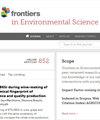Gypsum and organic materials improved soil quality and crop production in saline-alkali on the loess plateau of China
IF 3.3
3区 环境科学与生态学
Q2 ENVIRONMENTAL SCIENCES
引用次数: 0
Abstract
Arable soil and crop productivity are severely affected by salinization. Therefore, soil amendments are an important measure for improving saline-alkali soil for agricultural development. Desulfurized gypsum is a common soil amendment that has been used repeatedly alongside organic materials to improve the biological, physical, and chemical properties of saline soil. This study takes the typical saline-alkali farmland soil in Yulin as the research object, and five treatments were established: a blank treatment (CK), a single application 2.5 t ha石膏和有机材料改善了中国黄土高原盐碱地的土壤质量和作物产量
盐碱化严重影响耕地和作物产量。因此,土壤改良剂是改良盐碱土壤促进农业发展的重要措施。脱硫石膏是一种常见的土壤改良剂,与有机材料一起被反复用于改善盐碱地的生物、物理和化学性质。本研究以榆林典型的盐碱地土壤为研究对象,建立了五个处理:空白处理(CK)、单次施用 2.5 t ha-1 脱硫石膏处理(T)、2.5 吨/公顷的脱硫石膏和 1.5 吨/公顷的绿肥(TL),施用 2.5 吨/公顷的脱硫石膏和 1.5 吨/公顷的秸秆(TS),以及 2.5 吨/公顷的脱硫石膏和 1.5 吨/公顷的有机肥(TV)。结果表明,TV 处理显著改善了土壤养分、有机碳、酶活性和玉米产量。2022 年(2023 年),施用 TV 处理的土壤有机质、TN、TP、TK、AP 和 AK 与 CK 处理相比均有显著增加。与其他处理相比,TV 处理的土壤磷酸酶活性(SPA)、土壤脲酶活性(SUA)和土壤蔗糖酶活性(SSA)明显较高,并且在两年期间显著增加。此外,土壤有机碳 (SOC)、易氧化有机碳 (EOC)、溶解有机碳 (DOC) 和微生物生物量碳 (MBC) 也随着 2022 和 2023 TV 处理的增加而显著增加。相关分析表明,玉米产量与土壤养分、有机碳和酶活性之间存在正相关关系(P< 0.05)。因此,TV 处理被确定为土壤改良的最佳处理。利用成员函数分析、灰色关联分析和熵 TOPSIS 模型评估进行的分析也支持这一结论。因此,该方法可提高土壤质量,改善土壤肥力,实现玉米高产,为黄土高原盐碱地的改良和利用提供了科学依据。
本文章由计算机程序翻译,如有差异,请以英文原文为准。
求助全文
约1分钟内获得全文
求助全文
来源期刊

Frontiers in Environmental Science
Environmental Science-General Environmental Science
CiteScore
4.50
自引率
8.70%
发文量
2276
审稿时长
12 weeks
期刊介绍:
Our natural world is experiencing a state of rapid change unprecedented in the presence of humans. The changes affect virtually all physical, chemical and biological systems on Earth. The interaction of these systems leads to tipping points, feedbacks and amplification of effects. In virtually all cases, the causes of environmental change can be traced to human activity through either direct interventions as a consequence of pollution, or through global warming from greenhouse case emissions. Well-formulated and internationally-relevant policies to mitigate the change, or adapt to the consequences, that will ensure our ability to thrive in the coming decades are badly needed. Without proper understanding of the processes involved, and deep understanding of the likely impacts of bad decisions or inaction, the security of food, water and energy is a risk. Left unchecked shortages of these basic commodities will lead to migration, global geopolitical tension and conflict. This represents the major challenge of our time. We are the first generation to appreciate the problem and we will be judged in future by our ability to determine and take the action necessary. Appropriate knowledge of the condition of our natural world, appreciation of the changes occurring, and predictions of how the future will develop are requisite to the definition and implementation of solutions.
Frontiers in Environmental Science publishes research at the cutting edge of knowledge of our natural world and its various intersections with society. It bridges between the identification and measurement of change, comprehension of the processes responsible, and the measures needed to reduce their impact. Its aim is to assist the formulation of policies, by offering sound scientific evidence on environmental science, that will lead to a more inhabitable and sustainable world for the generations to come.
 求助内容:
求助内容: 应助结果提醒方式:
应助结果提醒方式:


